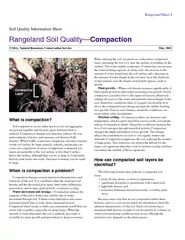

Compaction changes soil structure reduces the size and continuity of pores and increases soil density bulk density Wheel traffic or pressure weight per unit area exerted on the soil surface by large animals vehicles and people can cause soil compact ID: 69301
Download Pdf The PPT/PDF document "Soil Quality Information Sheet Rangeland..." is the property of its rightful owner. Permission is granted to download and print the materials on this web site for personal, non-commercial use only, and to display it on your personal computer provided you do not modify the materials and that you retain all copyright notices contained in the materials. By downloading content from our website, you accept the terms of this agreement.
USDA, Natural Resources Conservation ServiceMay 2001 reduced. Compaction changes soil structure, reduces the sizedensity). Wheel traffic or pressure (weight per unit area) exertedon the soil surface by large animals, vehicles, and people canlayers are generally at the soil surface or less than 6 inchesto large.When is compaction a problem?Compaction changes several structural characteristics andWater movement and storage.capacity of the soil to hold water and the rate of waterincreased runoff and, in some areas, increased erosion.Compacted wheel tracks or trails can concentrate runoff that canWater entering the soil can perch on a subsurface compactedlayer, saturating the soil to or near the surface or ponding on thethe water-holding capacity of sandy soils. An increase in thePlant growth.Where soil density increases significantly, itcompaction can limit roots to the upper soil layers, effectivelycutting off access to the water and nutrients stored deeper in theloss of soil nitrogen through microbial activity. Compactionchanges the depth and pattern of root growth. This changeaffects the contributions of roots to soil organic matter andnutrients. Compaction compresses the soil, reducing the numberof large pores. This reduction can restrict the habitat for thelarger soil organisms that play a role in nutrient cycling and thuscan reduce the number of these organisms.How can compacted soil layers beThe following features may indicate a compacted soilplaty, blocky, dense, or massive appearance;which root-restricting conditions may occur, although the http://www.statlab.iastate.edu/survey/SQI http://www.ftw.nrcs.usda.gov/glti(Prepared by the Soil Quality Institute, Grazing Lands Technology Institute, and National Soil Survey Center, Natural Resources Conservation Service,USDA; the Jornada Experimental Range, Agricultural Research Service, USDA; and Bureau of Land Management, USDI)The United States Department of Agriculture (USDA) prohibits discrimination in its programs on the basis of race, color, national origin, sex, religion, age,disability, political beliefs, and marital or familial status. (Not all prohibited bases apply to all programs.) Persons with dcommunication of program information (braille, large print, audiotape, etc.) should contact the USDA Office of Communications aTo file a complaint, write the Secretary of Agriculture, U.S. Department of Agriculture, Washington, D.C., 20250, or call (202) 720-7327 (voice) or (202) 720-1127 (TDD). USDA is an equal employment opportunity employer. Root-restrictingTexture bulk density (g/cmsand other than loamy very fine sand.......................1.80Very fine sand, loamy very fine sand.........................1.77Sandy loam................................................................1.75Loam, sandy clay loam..............................................1.70Clay loam...................................................................1.65Sandy clay..................................................................1.60Silt, silt loam..............................................................1.55Silty clay loam...........................................................1.50Silty clay....................................................................1.45Clay............................................................................1.40*Grams per cubic centimeter.What affects the ability of soil to resistMoisture.than moist or wet soils. Soils that are wet for long periods, suchthe landscape, where they receive runoff, are susceptible toand wheeled traffic. They become fluid and turn into Texture.Soil structure.Plants and soil organic matter.litter, and above-ground plant parts reduce the susceptibility tocompaction by helping to cushion impacts. Vegetation also addssoil organic matter, which strengthens the soil, making it moreresistant to compaction.What breaks up a compacted layer?Natural recovery is often slow, taking years to decades orshallow compaction, but it persists longer because it is lessaffected by the soil expansion caused by freezing. Shallowcompaction may be very persistent, however, in areas that arebetween soil particles. Plants with large taproots are moreeffective at penetrating and loosening deep compacted layers,while shallow, fibrous root systems can break up compactedlayers near the surface. Roots also reduce compaction byproviding food that increases the activity of soil organisms.Large soil organisms, such as earthworms, ants, and termites,Management strategies that minimizeMinimize grazing, recreational use, and vehicular trafficDo not harvest hay when the soils are wet.Maintain or increase the content of organic matter in the